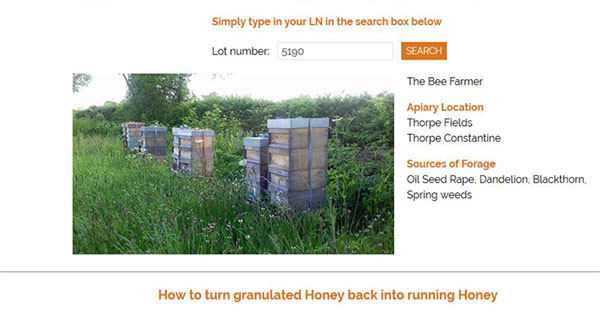Tracking your honey
Posted on 31st July 2017 at 23:53
Handmade food is all about provenance. After all it is why the public seek out sustainable and ethically produced products. The Bee Farmer has a way to demonstrate the provenance of his honey using a tracking engine.
Handmade food is all about provenance. After all it is why the public seek out sustainable and ethically produced products. The Bee Farmer has devised a way to demonstrate the provenance of my honey. One question I am often asked is "where are you hives?" I run about one hundred hives across the borders of Leicestershire, Derbyshire, Staffordshire and Warwickshire from my based near Ashby de la Zouch.

Folks may not know but honey differs in taste depending on the nectar sources the bees have foraged upon. In my part of the world the fields are relatively small although there is wide scales arable farming; we have hedges surrounding the fields, most of my hives are in the National Forest, there are preserved fields because they contain medieval ridge and furrow so are left to nature, the land is criss crossed with rivers, streams and ditches. The landscape gives the bees a fairly diverse sources of food. If you watch carefully you will see nature start to unfold in late February with Snowdrops,Daffodils, and Blackthorn. When the spring really gets going the fields are full of Oil Seed Rape, the hedges full of Hawthorn, Crab Apple, Bullace and Damsons. The orchards are awash with blossom of Apple, Pear, Quince and Plums. As we move into summer, the Horse Chestnut comes on stream followed by the Lime trees, There are brambles in the hedges and Beans in the fields. The local PYO (Pick Your Own) fruit farms are in full swing with all manner of soft fruits. In late summer as the arable crops ripen in the fields the road sides verges and waste grounds provide a superfluity of wild flowers, Cow Parsley, Meadowsweet, Rosebay Willow Herb to name but a few.
Mother nature rolls out a series of nectar giving plants from February to October all we needs is enough bees in each hive to profit from that nectar. If a hive of honeybees has a strong force of foraging bees and reasonable weather they are quite capable of collecting twenty pounds (10Kg approx) in less than two weeks. Modern hive such as the ubiquitous National hive (the model I favour) has removable portions of the hive called "supers". The bees are very accommodating in that they fill supers in turn as they are added to the hive. It is therefore possible given a strong honey flow to capture honey which has a high proportion of nectar from a single source in a single super.
In my part of the world my honey is more of a cocktail of nectar. Spring honey is likey to contain a higher proportion of Oil Seed Rape nectar simply because it is the most abundant nectar source in early spring. Recent scientific research indicated that Oil Seed Rape nectar made up about 50% of UK honeybee's diet in the spring. The remaining 50% will from a mixture of other spring flowers. Honey collected later in the summer will not contain Oil Seed Rape nectar therefore it will have a different structure, taste and aroma.
As a small honey producer I am able to extract my honey on an individual apiary basis. I store the extracted honey in separate batches. When I have an order or event to attend I put the honey into jars. Each jar has an LN code. Type the LN code into the Lot Number search field on the Tracking page and the origins of the honey will be revealed.


And as if by magic you get some information on the source of your honey.

So there you have it. Honey tracking at its best. From the field to the table. UK honey is a finite product. Only UK honeybees make UK honey and they can only do it at a certain times of the year and when conditions are favourable. Tracking should give you a link to the hard work that me and my bees do to give you a true taste of the English countryside. To get yours click HERE which takes you to the on-line shop.
Share this post:







